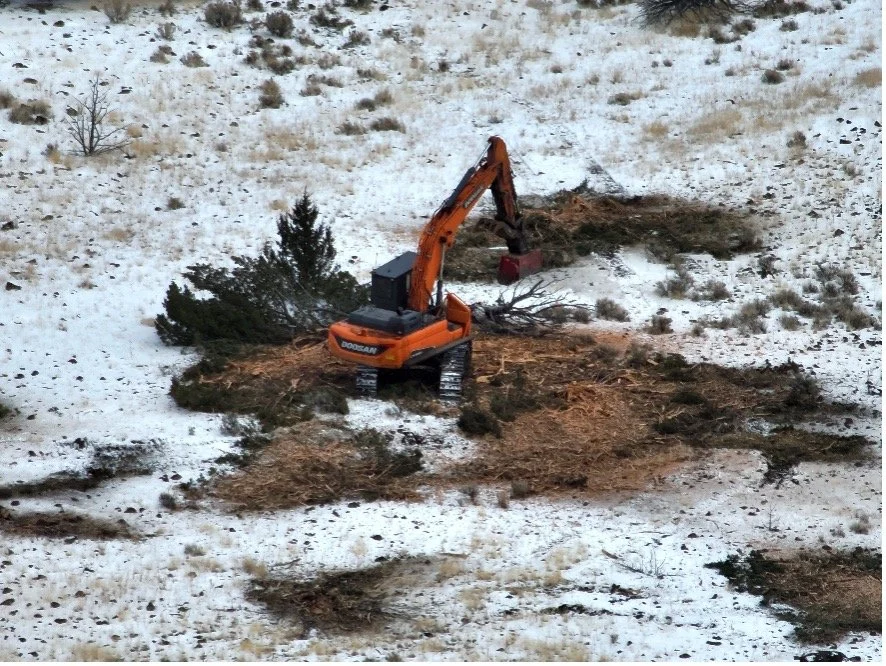
A Decade of Conservation Leadership at
Roaring Springs Ranch
When sage-grouse populations began declining across the West in the mid-2000s, ranchers in southeast Oregon watched with concern. The implications were clear: their operations could be profoundly affected by how this species' fate unfolded. Then, in 2014, the Greater Sage-Grouse became a candidate for federal listing under the Endangered Species Act, and the moment for action arrived.
Rather than waiting for regulatory mandates, a grassroots group of diverse stakeholders in Harney County sat down with the U.S. Fish and Wildlife Service to forge a different path. The result was the Harney County Programmatic Candidate Conservation Agreement with Assurances for Greater Sage-Grouse, a framework designed to facilitate voluntary conservation on private lands while providing landowners with regulatory certainty.
Roaring Springs Ranch stepped forward as one of the first to enroll. Their decision would set the stage for a thirty-year conservation partnership that demonstrates what's possible when ranchers, local conservation organizations, and federal agencies work together toward shared goals.
A juniper cutting project on the ranch reduced vertical structure threat to sage-grouse and improved hydrology and sagebrush habitat
Juniper mastication
Sage-grouse equipped with tracking collar
Scenes from Roaring Springs Ranch
Roaring Springs Ranch manager signs the CCAA
The partnership between Roaring Springs Ranch and Harney SWCD began with systematic assessment of the property’s lush meadows, and expansive sagebrush stands. Working together, they mapped habitat conditions across the property, identified specific threats to sage-grouse, and developed targeted conservation measures to address those threats. This groundwork culminated in a Site Specific Plan that would guide the ranch's enrollment in the CCAA.
The resulting conservation measures were comprehensive and precise. The ranch committed to maintaining contiguous habitat by avoiding fragmentation, a "no net loss" approach to both habitat quantity and quality. They created fuel breaks, used controlled burning in mosaic patterns to reduce juniper encroachment, and committed to maintaining hundreds of acres of high-quality sagebrush habitat through strategic juniper management.
Some actions created immediate results. In 2016, the ranch installed 31 trough ramps to prevent wildlife drowning and marked fences to reduce collision mortality. Other commitments were long-term: initiating habitat uplift on 500 acres of juniper-encroached habitat in the first decade, treating invasive annual grasses every five years, and developing grazing management strategies that consider sage-grouse needs alongside drought conditions.
Going Beyond Compliance
But Roaring Springs Ranch didn't stop at meeting their CCAA obligations. The ranch invested in understanding the species itself, launching an extensive radio-collaring project to track sage-grouse movements across seasons and years. With scores of birds equipped with VHF and GPS transmitters, patterns emerged: nesting areas, summer brood-rearing zones, winter concentration sites, and the pathways connecting them.
This knowledge transformed ranch operations. Armed with data about where and when sage-grouse used different parts of the property, the ranch implemented informed grazing management. They completed habitat improvements including native grass seedings, strategic juniper removal, invasive annual grass treatments, a minimum of 12 miles of roadside spraying annually, and installed 2 miles of fuel breaks in 2017. In a previously burned area they planted 2,600 locally grown sagebrush seedlings. All in, they have treated 1261 acres of juniper, an investment in habitat restoration that went well beyond their CCAA requirements.
Measuring Success
The results have been measurable and meaningful. Since monitoring began in 2013, sage-grouse populations on the ranch showed marked improvement following CCAA enrollment. In recent years, as conservation actions have continued and intensified, the numbers have climbed again. The data validates what ranch managers can see on the ground: the habitat is responding.
One of the ranch’s wildlife biologists using telemetry to track sage-grouse locations
Satellite imagery showing pre- and post-juniper removal on the ranch
The benefits extend beyond sage-grouse counts. The ranch's sagebrush rangelands are healthier and more productive, with many areas showing signs of ecological recovery. Riparian zones have improved. Native vegetation is thriving in pastures across the property, supporting not just livestock but a diverse array of wildlife species. The work has reinforced what the ranch already believed: sound ecological management and successful ranching operations aren't opposing forces, they're complementary.
"We want our great-great-great grandchildren to ranch here," explains ranch manager Stacy Davies. "So, the word 'sustainable'—what does that mean? To us that means that the land is going to be healthy and productive way into the future."
Looking Forward
After a decade of participation, Roaring Springs Ranch continues to identify new priorities: more targeted juniper removal in summer brood-rearing habitat, ongoing invasive annual grass treatments, strategic predator control, and exploration of virtual fencing technology for adaptive grazing management. Fencing spring and water developments to create mesic habitat protection. Prescribed fire to reinvigorate decadent plant communities in summer habitat areas.
"We have been very proactive in working with the government agencies to sign agreements that demonstrate that we are focused on rangeland health and wildlife success," Davies notes. "That gives us some flexibility that we would not otherwise have. We've been proactive in addressing problems and trying to solve them." The ranch's experience over the past decade offers a proof of concept for what voluntary conservation can accomplish when landowners, conservation districts, and federal agencies work as genuine partners.
As one of the early adopters in what has become 814,465-acres of enrollment across Oregon's private sage-grouse habitat, Roaring Springs Ranch demonstrates that long-term commitment to environmental sustainability isn't just aspirational language; it's a practical approach to land management that benefits both the operation and the ecosystem. The CCAA program has provided structure and accountability while supporting goals the ranch already held.
Sage-grouse males at a lek










